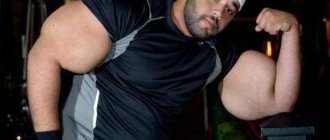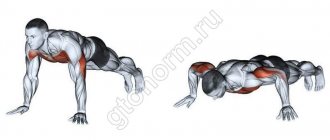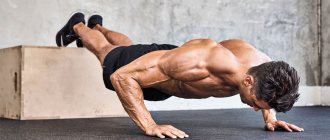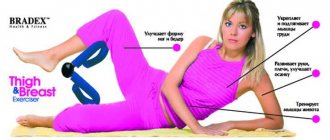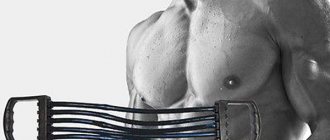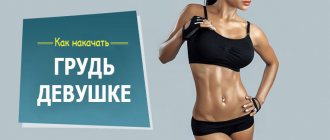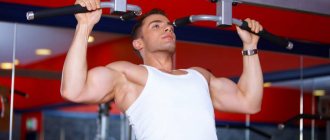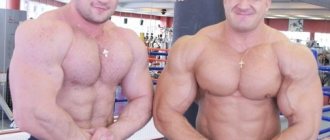How to pump up your chest muscles. 6 effective programs
We have to disappoint you right away, there is no universal training program to pump up your chest muscles.
Below are six proven workouts that will help you increase your chest size, no matter your experience. As they say, all roads lead to Rome. Only some get there much faster. Ultimately, most workouts sooner or later lead to results, but there is a more effective way: perform exercises that are maximally focused on results. All of the following training programs have different goals. Choose the one you need and use it for 4-8 weeks, on the day you pump your breasts. After this, you can return to your regular workouts or choose one of the following programs below.
Note : These workouts do not include a warm-up, but never forget about it. Just don't overdo it and don't warm up to muscle failure. In most of the exercises below, the main criterion for selecting weight is muscle failure - when you are unable to complete the exercise without a clear violation of technique or the help of a spotter. This is an indicator that you have given maximum load to the muscles. And as a result, muscle fibers received a powerful stimulus for growth.
For obvious reasons, in situations where no one is insuring you, you cannot go completely to failure - this can lead to serious injuries.
How to expand the chest? Complete How-To Guide
Good afternoon, honest people, take the faces out of your beards, tea, we are not having a memorial service, but quite the opposite! This Friday, oddly enough, we will pay attention to the male audience of the project, because our ladies are already all beautiful, and we will pull our brother up :). The topic of the note is how to expand the chest. And this is exactly what you will learn from it, or rather, we will look at the anatomy of the respiratory system, find out how to breathe correctly during strength exercises and, of course, analyze a specific training program aimed at volumetric breast enlargement.
So, guys, drive everyone away for the next 10 minutes, because there is a serious man-to-man conversation ahead.
Goal #1 - increase volume
Preparation
- Choose a weight that allows you to reach muscle failure for the number of sets listed below.
- Reduce the weight of the apparatus for more repetitions in subsequent sets. If you have a spotter, do the heaviest sets first.
- If no one is insuring you, train as close to muscle failure as possible.
Complete each last approach to each exercise with a drop set (after completing the last approach, take the apparatus approximately 25% lighter and, as it were, continue to perform the last approach until complete failure, and the pause should be minimal, preferably no more than 10-15 seconds). It is very effective for gaining muscle mass.
Mass gain workout
- Dumbbell bench press lying on a horizontal bench. 4 sets: 1st (6-8 reps), 2nd (6-8), 3rd (8-10), 4th (10-12) reps. We rest for one minute - ninety seconds.
- Incline barbell press . 3x (6-8), (8-10), (10-12), rest one minute - ninety seconds.
- Seated chest press. 3x(8-10), (8-10), (10-12), rest for one minute - ninety seconds.
- Raises with dumbbells on an incline bench. 3x10-10-12, rest one minute – ninety seconds.
- Reduction of arms in the butterfly simulator. 3x12-12-12 (several partial sets after reaching muscle failure on the last set), rest one minute to ninety seconds.
Goal #3 - Beginners
Preparation
Choose a weight at which you almost reach muscle failure. The first two exercises are performed using the pyramid principle: increase the weight after the first set and perform fewer repetitions.
Workout for Beginners
- Bench press in the simulator. 3x15-12-10, rest one minute - ninety seconds.
- Seated chest press. 3x15-12-10, rest one minute - ninety seconds.
- Reduction of arms in the butterfly simulator. 3x15-12-10, rest one minute - ninety seconds.
- Push-ups. 2 x until muscle failure, rest one minute - ninety seconds.
Goal #4 - Focus on the upper chest
Preparation
Workout with emphasis on the upper chest
- Incline barbell press. 4x(6-8), (6-8), (8-10), (8-10), rest one minute - ninety seconds.
- Smith machine incline bench press. 3x(8-10), rest one minute - ninety seconds.
- Incline dumbbell press (low angle, approximately 30°). 4x(8-10), (8-10), (10-12), (10-12), rest one minute - ninety seconds.
Superset
- Reduction of arms in a crossover on an inclined bench. 3x(10-12), without rest.
- Push-ups with your feet elevated, rest for one minute to ninety seconds.
Target #5 - Lower Chest
Preparation
Training with an emphasis on the lower pectoral muscles
- Bent-down barbell bench press. 4x(6-8), (6-8), (8-10), (8-10), rest one minute - ninety seconds.
- Incline dumbbell press. 3x(8-10), rest one minute - ninety seconds.
- Seated chest press. 4x(8-10), (8-10), (10-12), (10-12), rest one minute - ninety seconds.
On the subject: How to do push-ups correctly to pump up the pectoral muscles for girls
Superset
- Dips.
3 x until muscle failure, without rest.
- Crossover. 3x (10-12), rest one minute - ninety seconds.
Chest expansion complex
To achieve the effect of such exercises, it is not enough to simply do exercises once a week to expand the chest bones. You should devote time to this complex, allocating a separate training program for it. You can do chest expansion every other day, and on rest days you can actively stretch the chest with Rader rows and “sun exercises” with a stick. But growth is a physical expression of the body's adaptation to stress, so the body needs time to recover and achieve supercompensation . When it comes to the growth of muscle structures, circuit training is suitable for beginners and the body has time to recover, then the athlete moves on to a split, training each muscle once a week, that is, giving the body a rest per week to restore muscle structures. As an athlete becomes more experienced, he begins to use microperiodization to give the body enough time to restore specific muscle fibers .
In the case of chest expansion, it is even more difficult, since this adaptation requires more resources and time. That is why chest width should be developed in periods, that is, using the principle of macroperiodization. The system looks like this: the athlete spends a month expanding the chest, then rests for a month, training according to the usual scheme, after which he again moves on to expanding the skeleton, but for a month and a half, then rest again, also for one month, and finally 2 months workouts to expand the sternum, which give the greatest impact. If you are afraid of losing muscle mass during this time, then you will lose it, but it is worth it! All the advantages of the training have already been described above, and if you want to achieve maximum results in muscle growth, then you should be patient, the patience of a hunter, and prepare yourself for hunting truly big game!
Goal No. 6 - pre-fatigue of the pectoral muscles
Preparation
Training with pre-exhaustion of the pectoral muscles
- Incline dumbbell flyes. 3x10, rest one minute - ninety seconds.
- Butterfly trainer. 4x8-8-12-12, rest one minute - ninety seconds.
- Bench press.
3x(8-10), rest one minute - ninety seconds.
- Incline dumbbell press. 3x10, rest one minute - ninety seconds.
- Smith machine incline bench press. 3x (10-12), rest one minute - ninety seconds.
Nutrition and recovery
After your main workout in the gym, it is recommended to do stretching exercises. This will reduce tension and restore muscle elasticity. An experienced trainer will help you choose the right exercises. A set of stretching exercises is recommended to be performed after each workout.
To restore muscles after training, you need to properly organize your diet. After strength training, it is recommended to use a gainer or whey protein shake. These sports drinks contain beneficial amino acids, vitamins, and minerals that quickly restore muscles. Some sports disciplines require less energy than strength training in the gym. Stretching, Pilates, yoga, and aerobics are very popular in fitness clubs. After such physical exercises, it is good to use fruits, natural yogurt, and a sports bar. An additional meal after training may consist of protein foods. It is better to use chicken fillet, beef, cottage cheese. When performing physical activity, you need to restore your water supply. It is better to use drinking water or isotonic drinks for this. After training, you can additionally drink a protein shake, which will provide the muscles with nutrients and amino acids. The whey protein drink is quickly absorbed.
It is important to follow a training and rest regime when playing any sport. Professional athletes usually train every other day. When preparing for competitions, athletes can exercise at a fitness club with greater intensity. At the same time, at each training session, exercises are performed for individual muscles, which allows the athlete to rest consistently. Experienced trainers can always help beginners and experienced athletes in creating a training program. The average gym goer doesn't need that kind of intensity. It is recommended to exercise three times a week. The duration of the workout depends on the number of exercises and the recommendations of your trainer. Before and after training, it is recommended to do a short warm-up and cool-down.
A good option for relaxing after class is a massage. Massage helps you relax, reduces tension, and improves muscle nutrition. Some fitness clubs offer massage programs to visitors. Massage is best done after exercise or in the evening to better relax.
When doing fitness and strength sports, it is important to choose the right intensity of exercise. When creating a complex, be sure to consult with your trainer and doctor. Experts will help you choose the best course option. Additionally, you need to follow a diet. The menu should be based on regular products. Protein shakes should be used after training and between meals.
Source
Proper nutrition and medical techniques for breast enlargement
Proper nutrition helps the chest grow, since in order for breasts to grow, “building” material is needed. Accordingly, there are a number of products that a young person should consume daily.
- Breasts will increase in size only if you eat foods rich in carbohydrates. However, it is important to focus not on confectionery products, but on carbohydrates contained in legumes and grains.
You also need to eat more protein. If a man works out in the gym at least 4 times a week, then the proteins he consumes will help his chest bones grow. To grow breasts, you should eat at least 400 g of protein-containing foods every day: milkshake, meat, eggs, seafood, fish.- Fat-containing products. You should eat nuts, pork, butter, fatty fish.
Important! If a young person eats properly and consumes a balanced diet, then he does not need to use protein shakes.
In the question of how to develop the chest, medicine comes to the rescue in the case of funnel syndrome, which people call “shoemaker’s chest.” This pathology is rare, occurring in only 0.1% of the entire male population and is considered not only a cosmetic defect, but also interferes with the normal functioning of the body. Medicine has in its arsenal both surgical and conservative methods of its treatment.
On topic: The pectoral muscle twitches on the right
The latest methods include a vacuum bell, which acts as an external force. This technique is effective only when the chest frame is just being formed. In addition, it is recommended to use it for a long time. The device, which creates a vacuum over the deformed area, can be ordered in Germany in an individual size.
If the defect is small, it is possible to fill the affected part with Macroline gel, which masks the depression. Also, at a young age, corsets and specially designed exercises can be used to correct the defect.
Surgical techniques that must be used in extreme cases include:
- sternochondroplasty,
- minimally invasive correction.
Using these methods, a reduction plate is inserted under anesthesia. These techniques differ only in the possibility of inserting a plate. In the first case, the sternum is dissected and the altered cartilage is removed; in the second, the plate is inserted using mini-incisions on the sides.
The question of how to reduce a young man’s chest can only be answered by a doctor. First of all, if there is a discrepancy in the parameters, you need to contact a specialist for diagnostics.
Typically, chest reduction at home can be achieved using:
- nutrition correction,
- frequent and small meals,
- daily jogging,
- push-ups,
- dumbbell raises,
- dumbbell press.
If you wish, you can develop your chest at home without much difficulty. However, it should be remembered that it is possible to achieve the desired result only until the age of 18-20; in the future it will be much more difficult to do.
Source
How to enlarge the chest
Many athletes try to increase the volume of the pectoral muscles in only one way - chest training. In order to get well-developed pectoral muscles, a standard “attack” on the chest is not enough. In parallel with this, you need to increase the volume of the chest. Using this method to build pectoral muscles, you will quickly get the desired result.
To directly enlarge the chest, most professional athletes use 2 methods:
— deep breathing squats with a barbell;
- pullover exercises with gradual progression of weights.
By following these simple methods, an athlete can achieve tremendous chest growth. Let's look at these exercises in more detail.
1. Deep breathing squats with a barbell on the shoulders.
Performed like standard barbell squats. The only difference is that you inhale and exhale completely while standing after each repetition. It is very important to follow the correct technique. To follow the technique, use the Smith machine; this mechanism will allow you to get the full benefit of breathing squats. As for weight, everything is a little simpler here. Use 75% of your working weight; this will not harm your technique and will allow you to inhale and exhale fully on the lift.
Another trick is to take 3-4 full breaths after every fifth repetition and only then continue the repetitions. The number of repetitions should vary from 12-15. However, some athletes use a different system of 20 repetitions per set, and they divide these repetitions as follows:
- full inhalation and exhalation on the 6th repetition;
- full inhalation and exhalation for 12 repetitions;
- full inhalation and exhalation for 18 repetitions;
- 3-4 full inhalations and exhalations for 19 repetitions.
It is important to remember that when directly squatting with a weight, you must inhale slowly and correctly, and when rising to the starting position, you must exhale correctly and slowly. Plus, you still have full breaths and exhalations left. Only strict adherence to technique and correct inhalations and exhalations will provide you with enormous benefits from this exercise.
On topic: Push up gymnastics for chest
These exercises can also be alternated with hack squats or any type of deadlift.
But as mentioned above, one exercise will not be enough. This is where pullovers come to our aid. Pullovers to expand the chest are performed only with a dumbbell. Remember this. Currently, the Internet is full of all kinds of false and fundamentally incorrect information that pullovers are best performed on machines or with a bar. This information is beneficial to manufacturers of the relevant simulators. But this is already a deviation from our main topic.
2. Breathable pullovers.
Let me remind you that pullovers are the only exercise that equally strains the latissimus and pectoral muscles. Also a side effect here are the triceps. For this exercise you will need a horizontal bench and dumbbells of various weights.
Take a starting position in which your shoulder blades will be on the bench. The back extensors, roughly speaking, will be in zero gravity. Bend your knees at a right angle. The body should be parallel to the floor. Take a dumbbell (with both hands at either base), or ask your partner to hand it to you. Next, pull them perpendicularly upward with straight arms - this is the starting position of the breathing pullovers.
Begin to lower the dumbbell slowly and under control, trying to bend your elbows as little as possible. Lower your arms until the base of the dumbbell you are holding is just below your head. Stay in the critical position for literally 1 second and slowly, slowly return to the starting position.
The difference between breathing pullovers and simple ones lies not in the technique of execution, but in the starting position. For simple pullovers, an incline bench is ideal, with your head lower than your feet.
In order for pullovers to expand the chest, you should resort to the already familiar method of exhalation and inhalation. It is better to do full exhalations and inhalations according to the following scheme:
- 1 full inhalation and exhalation for the 7th repetition;
- 2 full inhalations and exhalations for 12 repetitions;
- 3 full inhalations and exhalations for 18 repetitions.
The number of repetitions should be at least 18, the ideal number of repetitions for breathing pullovers is 20. If you do not feel the proper load, increase the working weights. Increasing weights is a great way to expand your chest.
One trick is to arch your back while lowering the dumbbell to your head. The more you arch your back, the more your chest will tighten. To better understand this principle, study anatomy. However, in bodybuilding, the main thing is to stop in time - arching your back does not at all mean that you should arch at an unnatural amplitude. Under the arch, a slight arch of the back is perceived.
Breathing pullovers can be alternated with Rader rows to the chest using the standard inhalation-exhalation method.
- weight progression is the key to expanding the chest (5% each workout);
- technique, as in other exercises, plays an important role;
— the chest should be expanded in 1 training session, every 2-3 weeks.
You should start training to expand the chest with simple pullovers, turning into breathing ones. Then you can move on to more complex breathing squats.
In fact, it is not possible to physically increase bones. What is the positive effect of the above exercises? It's simple! In practice, hypertrophy of the muscles of the entire torso creates a visual effect of expansion of the chest. That is, by performing the above exercises, you will enlarge your chest only visually.
Subscribe to our channel to receive new articles!
Source
How to expand the chest: the practical side of the issue
If you take a quick look at your gym, you will draw the following conclusions about the goals of the trainees, namely: young ladies want to lose weight and become smaller, guys need to enlarge or lengthen everything :). And because The pectoral muscles are one of the largest muscle groups, so increasing their volume will make a significant contribution to improving a person’s composition.
By the expression “expand the chest” (in the context of this note) we will understand the following:
- increase in chest width (horizontal linear size);
- adding “depth” (increasing vertical size);
- adding volume (increasing size in girth);
- increase in muscle mass.
All this is achieved through a special training program aimed at “pulling out” the breasts by influencing the anatomical features (including the pectoral ones). What they are, we will find out further in the text.
“Tools” for chest expansion
First of all, take a crowbar and an expander and...
To expand the chest, the athlete must strongly influence 3 components:
Let's go through each “tool” separately and start with...
I. Expansion of the skeleton
Did you know that bone completely remodels itself every three months? This suggests that if time is not lost (the athlete is young, under 25 years old, and his growth zones are still open), then he can “build up” his bones, i.e. Conventionally, from a 15 cm wrist, make 17.5-18 . Bones react to weight, i.e. their density increases as the weight used by the athlete increases. Thus, the training strategy for a beginner who has decided to “bone” increase should be a gradual transition to basic movements, strengthening ligaments/tendons and increasing the weight of the weight, and not swinging the press on a bench and doing dumbbell bicep curls.
To stimulate your skeletal system to grow, use the following “tricks”/exercises:
No. 1. Holding your breath
Do the following exercise for a long time ( 3 months) every morning:
- clasp your hands in front of your waist and take as deep a breath as possible;
- hold your breath while raising your clasped hands up to a position in front of you;
- while holding your breath, try to move your arms to the sides, overcoming the resistance of your clasped hands;
- stay in this “extended” position for as long as you can;
- repeat 15 times.
No. 2. Breathing squats
The exercise is as follows: classic squats are performed with a barbell on the shoulders according to the following scheme:
- before starting squats, take 3 large breaths;
- after the 3rd inhalation, the breath is held and a squat with the barbell is performed to parallel with a quick “rise to the top”;
- after straightening, exhale strongly;
- the pattern is repeated;
- only 3 sets of 15-20 repetitions.
On the subject: How to grow pectoral muscles
II. Working with connective tissue
Here pullovers with a dumbbell/barbell lying across the bench will help us/you. This is an excellent exercise for strengthening and stretching the connective tissue of the pecs.
III. Work on all 3 sections of the pectoral muscles
The total development of the pectorals will give the necessary increase in “meat” over their entire area, i.e. will allow you to gain the necessary muscle mass. This will relieve you of “skinny” breasts. The main exercises are dips, bench press (different angles) and military chest press.
This was all about the 3 components, by acting on which the athlete will be able to “expand”. Now let's talk about...
How to expand the chest: technical aspects of training
There are the following 2 “technical keys” that should be used in chest expansion training:
No. 1. Full range of motion
In the plane of the muscle mass of the pectoral muscles, external (O-outer) and internal (I-inner) parts can be distinguished. You train the outer pecs when you use the full range at the bottom of the movement—only the full stretch will maximize chest width development. In other words, if you want to increase the width of your chest, you should work the outer part of your pecs, allowing the bar to go as far down as possible (until it touches your chest). Working the inside of the pectorals (near the middle of the chest) increases its thickness.
The trick to chest width training is to use dumbbells instead of barbells for bench presses. It is these projectiles that allow you to bring the shoulder blades together more and stretch the pectoral blades at the lower point of the trajectory.
Conclusion: when training the chest for width, it is better to take less weight, but work at full amplitude.
No. 2. Antagonist muscle training
Antagonist muscles are those muscles that act against each other and have opposite effects on a joint. The biceps and triceps are antagonists of each other, the first bends the elbow joint, the second straightens the arm. If an athlete trains only the chest muscles without their antagonists, this will affect posture (in particular, pushing the shoulders forward and hunching) and reducing the width of the chest. As a result, such a tandem - a combination of large pecs on a narrow chest - can lead to an unpleasant aesthetic embarrassment.
The antagonists of the chest muscles are the upper back muscles, among which the most important are the latissimus, trapezius, rhomboids, teres major/minor, supraspinatus and infraspinatus. So, when the pectoralis major pulls your shoulders forward, your upper back muscles (including the rear deltoids) pull your shoulders back.
Conclusion: You should give equal attention to training your chest muscles as well as your upper back, as this is the key to keeping your shoulders in a neutral position and getting a wider chest.
We seem to be done with the theory (really :)) and now let’s get down to concrete practice, namely...
How to expand the chest? Training program
Well, for dessert we have one highlight of the program :), a special PT, which is designed to transform your breasts from a plane dimension into space (volume).
Training parameters for the gym:
- quantity per week - 2;
- intensity - moderate/normal;
- superset/triset - involves performing exercises one after another like a train without rest;
- rest time for m/y sets - 40-45 seconds;
- number of approaches/repetitions - specified;
- stretching the pectoral muscles after each set of exercise.
The program itself and the atlas of exercises present the following picture.
Follow the indicated schemes for at least 2.5 months and you will have to run to a women's bra store, because from size zero your breasts will become a solid two :).
We're done with the substantive part, let's move on to...
How to increase the size of the pectoral muscles for a man
Every man
Anyone who decides to go to the gym sooner or later wonders how to quickly pump up his pectoral muscles. First of all, it seems that it is actually quite simple: do a bench press, do push-ups, and the fibers will develop on their own. Of course, up to a certain time, the pectoral muscles will grow, but then, without the use of competent methods and analysis, the process will stop.
When the growth of the pectoral muscles
slows down, many begin to think that the problem is genetic, they begin to despair and sometimes even quit the gym without achieving their goal. Not all athletes who regularly visit the gym have well-defined and clearly defined pectoral muscles. How to pump up your pectoral muscles? Let's look at the basic methods.
The main mistakes in working on the pectoral muscles
Young people
who begin to work on that body, immediately begin to bench press on a horizontal bench, believing that this particular exercise will give significant growth. Over time, athletes notice that the muscles have changed exclusively in the center of the chest, while the upper and lower parts remain undeveloped.
After some more time for exercise
Even the middle of the chest stops responding, and growth stops. And here the problem is choosing an exercise exclusively on a horizontal bench. What can be changed in this situation? Urgently change exercises on a horizontal bench to training using an inclined bench. The method consists in the fact that the central part of the pectoral muscles changes visually under any load; working out the upper and lower parts is much more difficult.
On topic: Exercises for breasts for women with a pattern
When tilting, the lower and upper parts actively work
, so in just a couple of months you will be able to see significant changes; you would not have achieved this by doing only the bench press on a horizontal bench.
— Add a Dumbbell Press
. The exercise is isolating, so you can load exclusively on the pectoral muscles and correct their appearance. The fly doesn't actually provide the significant strength gains that the bench press does, but if you're looking to increase the size of your pectoral muscles, this exercise is a must-have.
The triceps take an active part in the wiring
, but he is a small muscle, so when he is already tired, the exercise turns out to be more isolated and local.
Choose a barbell or dumbbells?
If the main exercise
is the bench press, it is worth noting that you can perform it with both dumbbells and a barbell. Many athletes want to know the exact answer so that they can choose one thing for sure. Experienced bodybuilders claim that both are equally suitable for working out the pectoral muscles.
For some who are used to dumbbell bench presses
, changing them to a barbell leads to incredible muscle growth due to stress and leaving a certain comfort zone. Don't forget that you should always surprise your muscles by adding or subtracting certain exercises. By doing exercises with dumbbells, you can increase the amplitude, which means that the work will be deeper, contributing to weight gain and improving the appearance of your body.
How many sets and reps should I do?
To gain weight
in the chest area you need to learn to take a heavy weight that you can lift no more than 6-12 times. Otherwise, you won't apply enough stress and your muscles won't grow. The most you can do is increase your endurance, but is this really necessary in your case? Pay attention to the method of performing four approaches, if we talk about the barbell press, in the case of dumbbell flyes there should be 3 approaches, but 5-6 times more per repetition.
So, it turns out that we do the dumbbell press 8-13 times for three approaches, and the dumbbell press 6-10 repetitions for 4 sets.
How often do you do workouts for the pectoral muscle groups?
For some reason, many people think that the more often they do exercises
on the pectoral muscles, the faster and better they will grow. However, this is a myth, everything is completely different. The pectoral muscles are one of those groups that need to be trained no more than once a week. Do not forget that the pectoral muscles must have time to recover, otherwise they will lose volume and strength.
If you want to lose weight
, then you don’t need recovery as such, because the body should constantly be under slight stress, spending more than it consumes. If we talk about gaining weight, then rest should be complete, only in this case you will be able to notice progress. Chest muscles grow not in the gym, but outside it. With competent exercises you only give them a boost.
Technical features of working on the pectoral muscles
:
1. Grip width
. Wide is effective, of course, but its constant use can lead to stunting of muscle growth. The fibers quickly get used to a certain level of load, so you must change it regularly. Try alternating between medium and close grips, performing an exercise for 1-2 weeks, and another for 3, and so on again. This way, you will regularly feel the load, and your muscles will not get used to a certain grip width.
2. Breath
. In any physical exercise, it is very important to breathe correctly in order to avoid unnecessary stress on the heart. When lowering the dumbbells or barbell down, inhale; exhale should occur at the most difficult stage of the exercise. In this way, you will help yourself cope with the load and prevent an increase in blood pressure.
3. Amplitude
. The greater the amplitude of the exercise, the faster and more effective muscle growth will be. Try to lower your arms as much as possible while pressing dumbbells, but in no case provoke the appearance of pain in your elbows. If we talk about the barbell press, the amplitude cannot be too large. Bring it all the way to your chest, without leaving a gap, as many beginners do.
4. Rhythm
. If you've watched bodybuilders, you've probably wondered why some do the exercise quite quickly, while others do it slowly. A similar principle applies here, which is described above in the nuances of grip width. You must constantly alternate the rhythm of the exercises. One workout, do quick jerks, pushing the barbell or dumbbells up, the other day, slowly see the weight down and then up, increasing the amplitude as much as possible.
Source
The main mistakes that are made when training the pectoral muscles!
1. Lack of progressive load on the bar when performing basic exercises.
To force the body to hypertrophy the pectoral muscles, it is necessary to increase the weight of the apparatus in basic exercises at least once every two weeks. Remember this expression as an axiom, and always say it during your next workout. If you don’t adhere to the rule described above, it doesn’t matter at all: recovery, the amount of protein per kilogram of body and new, trendy exercises in the gym.
The body needs compelling reasons to begin the process of overcompensation after recovery and increase the number of myofibrils in muscle fibers. Regularly increasing weights is a good reason that will make the pectoral muscles grow, even in a person with poor genetic data.
2. There is no accentuated contraction of the pectoral muscles during the exercise.
You just have to look at the technique of performing basic exercises and everything returns to normal. How can the pectoral muscles grow when, when performing a bench press on a horizontal bench, everything is worked out, but not the chest. Now the question does not concern athletes who use a unique technique aimed at developing maximum strength in a single repetition.
Remember that, unlike powerlifting, our goal is not to make it easier, but to complicate the work of the pectoral muscles. And this applies to every exercise aimed at developing the chest; the use of cheating transfers the load to the deltoids, latissimus dorsi and triceps. Naturally, if the muscle group is not sufficiently worked out, growth will not occur.
3. Using a large number of exercises to work one muscle group.
You are not professional bodybuilders, whose recovery abilities are tens of times higher than the average gym goer. Therefore, there is no need to use a large number of exercises to train the pectoral muscles, half of which are isolating.
When training a large muscle group, it is enough to perform three exercises to fully work out the fibers from different angles. Walk into any fitness center and you get the impression that everyone around you is preparing for the Mr. Olympia competition. At the same time, athletes use the entire list of exercises to pump up their chest muscles. Naturally, this approach in 99% of cases leads to overtraining and, instead of growth, causes a catabolic phase and reduction of the pectoral muscles.
The main postulate is as follows: “when training the chest muscles, use no more than three basic exercises and completely eliminate isolating movements”
4. By training the chest muscles, athletes only assume that they have injured the muscle fibers and triggered the growth mechanism.
When you finish an exercise and feel a burning sensation, this does not mean that you have reached muscle failure. In 90% of cases, too much lactic acid has accumulated between the muscle fibers, which makes it difficult for the myosin and actin bridges to adhere and disengage. However, this does not mean at all that microtrauma of the fiber has occurred.
Let's dig deeper into the truth! The muscle contracts because actin and myosin bridges interlock. When energy resources (glycogen) run out, some bridges do not have time to disengage and they rupture, which is accompanied by fiber injury.
However, if you delay the execution of the approach beyond a certain time period, the body begins to switch to an autonomous method of energy, called aerobic glycolysis. And this means that there will be no growth of chest muscles.
REMEMBER: “In order to injure the fibers, muscle failure must be achieved within a period of 15 to 30 seconds. If the time spent under load exceeds the thirty-second barrier, the body will begin to use an alternative type of energy and injury will not occur.”
LOAD PROGRESSION + REACHING FAILURE WITHIN A 30 SECOND PERIOD + BASIC EXERCISES! Here's the answer to the question: how to pump up your pectoral muscles?
